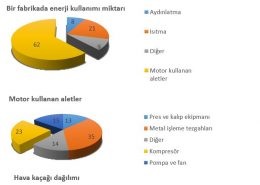
Electricity Savings in Businesses
Reducing energy costs by monitoring Compressed Air consumption
Many factories have already taken the necessary measures in terms of "energy saving" in electricity consumption. Most of the controllable consumption items such as improper lighting or heating have been brought to optimum levels with automation applications that follow human behavior in the enterprise. Now, standard applications such as reactive power control, periodic maintenance of motors are the default methods. From building insulation to the selection of lighting fixtures, so many issues have been addressed in production and life, and serious investments have been made in this regard that it will be much more difficult to go one step further in savings from now on.
In this article, we will try to examine the additional savings that can be accomplished by controlling the use of compressed air. The assumed reality is that the weight of air compressors is around 20-25% in the total electricity consumption of a factory. This means that the control of the compressed air system, if well managed, can contribute to the overall savings. The initial point for creating sensitivity in energy saving is to start off with the determination of the current situation. Collecting and monitoring each type of energy will first raise awareness of employees and therefore show sensitivity for improvement.
At this stage, we can present a new technology in the measurement of compressed air flow. We will talk about the ultrasonic flowmeter developed by the Japanese company Aichi to measure the compressed air flow. As a preliminary argument, we can start with the fact that there is no protrusion or contraction in such flowmeters, which will cause "0" pressure loss. A much more essential issue is that they are not affected by oil and water particles in the air. Another issue is that there is no need for any filter in the facility of Aichi ultrasonic flowmeters, and therefore it will not bring additional filter or cartridge cost or cleaning burden.
The features of Aichi ultrasonic flow meters can be listed as follows.
Since there is no pressure loss, there is no energy loss.
Compared to other measuring principles, ultrasonic measurement is stronger against dust and moisture.
It is better in terms of durability as there is no obstacle in it.
It provides measurement over a wide range. (1…400)
Compared to the orifice plate (differential pressure), vortexmeter and thermal mass flow meters used for compressed air flow measurement, which have some problems until today, Aichi ultrasonic air flow meters will appear to have a clear advantage.
No need for filter installation and filter cleaning.
It is not affected by dust, moisture or oil contamination. In case of high pollution, vertical line mounting is recommended.
Comparison between Ultrasonic and Thermal type
Performance evaluation between TRX and thermal mass flow meters
The TRX was installed on the line right after the compressor, then a mass flow meter was installed.
To confirm the performance of both flow meters in 100% humid air, they were operated for 5 hours.
5 minutes after starting the experiment, the accuracy of a diaphragm gas meter and the other two flow meters were compared.
Although the TRX was mounted closer to the compressor, it was not possible to measure with a mass flow meter 7 minutes after starting the experiment. The TRX has also shown that it measures more accurately than the diaphragm gas meter placed for comparison.



